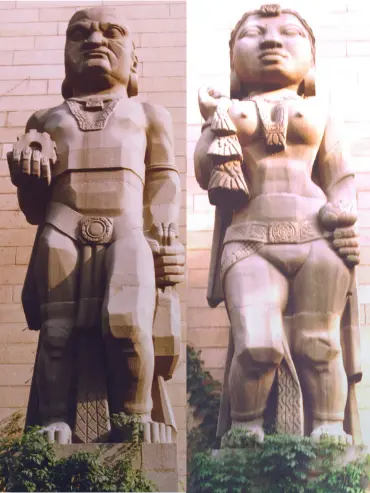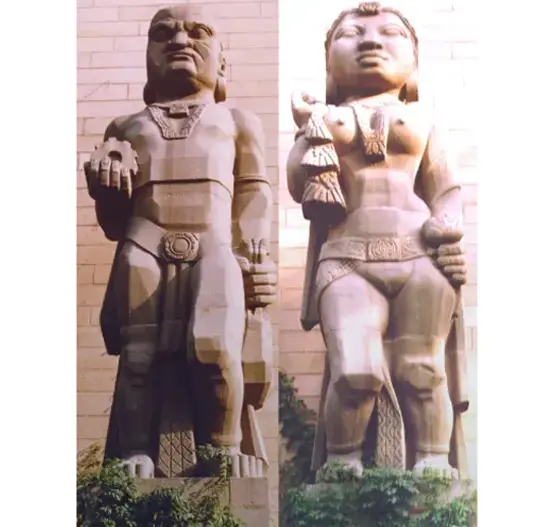Anecdote 3: Of Art, Central Banks, and Philistines - ಆರ್ಬಿಐ - Reserve Bank of India
Anecdote 3: Of Art, Central Banks, and Philistines
On achieving independence, the government planned a number of public buildings to house the institutions of independent India. In this context, Pandit Jawaharlal Nehru, the Prime Minister, suggested that public buildings, many of which were large imposing structures, could be utilised to ‘encourage Indian artists to function in some way’ and sculptors, painters, designers, etc. could be asked to cooperate. Nehru opined that the art work ‘…should cost very little in comparison with the total cost of the buildings. But it will encourage Indian artists and would be greatly welcomed, I think, by the public’. The Finance Secretary, Shri K.G. Ambegaokar, sent a copy of the note to B. Rama Rau, the then Governor. This was the time when the Reserve Bank was in the process of constructing/contemplating new buildings at New Delhi, Madras and Nagpur. Accordingly, the Bank set up a committee consisting of Shri J.D. Gondhalekar, Dean of the J.J.School of Arts, Bombay, Shri G.M. Bhuta of M/s Master, Sathe & Bhuta and Shri R.D.Pusalkar, Assistant Chief Accountant of the bank to examine the proposal and to make recommendations on the subject.
Amongst other schemes, the Committee recommended that sculptures could be erected on either side of the main entrance of the RBI office at New Delhi, one depicting the idea of “prosperity through industry” and the other “prosperity through agriculture”. At the instance of J.R.D.Tata, the then Director of the Central Board, the views of Carl Khandalawalla, an eminent critic and connoisseur of art, were sought. It was he who suggested that the Bank could consider having figures of “Yaksha” and “Yakshi” on the two sides. On his advice, the the invitation to tender for the adornment of the frontage of the New Delhi Office was extended to the nine artists.
Out of the nine artists invited, five submitted their proposals and amongst them only one submitted models and sketches. The proposal of Shri Ram Kinkar Baij was accepted. The art form of the male ‘Yaksha’ was drawn from the statue of the ‘Parkham Yaksha’ in the Mathura museum and the art form of the female Yakshi was derived from “Bisnagar Yakshi” from the Calcutta Museum. Shri Khandalawalla felt that these massive figures would go very well with the architectural features of our New Delhi office.
While the themes of peasant-worker prosperity drew upon Nehru's 'scientific temper', its manifestation in the form of the Yaksha and Yakshani appealed to the sensibilities of those steeped in tradition - according to Hindu mythology Yakshas belongs to a class of demi-gods and they are represented as the servants of ‘Kubera’ the God of Wealth. The duty of Yakshas is to guard over Kuber’s gardens and treasures. The Yakshi is a female yaksha. The Bank by virtue of its having the sole right of note issue and being a banker to the Central and State Government could, therefore, be compared with Kubera - the lord of wealth and the statues of the Yaksha and Yakshi could assume the duty of guarding the Bank’s treasure. In the modern context, the figures could also be given the allegorical interpretations of symbolising industry and agriculture, subject matters with which the Bank as a Central Bank of the country was directly or indirectly concerned.
The saga of the sculptures exercised the Bank officials for quite a while as the artist, Ram Kinker, took his own time in selecting the exact quality of stone that was needed which entailed exploration of sites, stone quality, problems in its quarrying and transportation to New Delhi. The work was subject to very considerable delay and on many an occasion the Bank felt that the while Shri Ramkinker may be possessed of excellent artistic merit, he perhaps did not have the management skills to undertake the enterprise. By the time the sculptures were ready chiseled and polished around December 1966 (January, 1967), the original estimates had to undergo a considerable revision.
That, however, was not the end of the story. When the statues were finally installed, it was over ten years since they had been commissioned; in the meanwhile, the times and circumstances, and the outlook of the country and its leaders had changed. The statues, when being installed at the Reserve Bank’s New Delhi Office at Parliament Street, did seemed to offend the prudish sensibilities of parts of the populace; the specific cause of provocation was the statue of the Yakshi, depicted in her natural beauty.
The issue of the statues was raised rather starkly in the Rajya Sabha by Prof. Satyavrata Siddhantalankar:
‘Will the Minster of Works and Housing and Supply be pleased to state:
- Is it a fact that the statue of a naked woman has been erected in front of the Reserve Bank of India, Parliament Street and
- If so what is the object in erecting this statue of a naked woman?’
An exigisis that the ‘naked woman’ was essentially an allegorical interpretation, representing agriculture and wealth was perhaps convincing though not without further supplementary questions regarding costs incurred and the details of the committee who recommended the art.
While the cause of disquiet generally was the Yakshani, the popular weekly tabloid, Blitz, certainly not prudish in its outlook or ill informed of art, characteristically put an entirely different angle to the statues and likened the Yaksha to resemble Sadoba Patil, an industrialist. Against the title “Yaksha Patil”, Blitz depicted a photograph of the statue and commented “….But artist Ram Kinker’s conception of a modern Yaksha, which now guards the Reserve Bank, has, coincidentally enough, taken an amazing likeness to Sadoba Patil, one of the most zealous ‘guardians’ of wealth and big business in the country…”
In the wake of the Blitz article, it was felt that the misunderstandings the statues gave rise to could perhaps be addressed by issuing a suitable Press Comminique and issuing hand outs on the art the Bank had commissioned; alternately it was felt that issuing handouts and communiqués would once again revive the controversies. The consensus finally veered in favour of silence. The early nineteen fifties, when Pandit Nehru had conceived the idea of encouraging art, were an era of optimism, different from the lean period of the sixties when, art had, perhaps, to be relegated to the background. Governor P.C. Bhattacharyya, perhaps had his fingers on the pulse when he remarked “Let sleeping dogs lie! Neither the decision to spend the money nor the delay associated with the execution of the project can be justified in the present day context. It would be equally futile to explain through a press note the symbolic significance of the figures put up. We can deal with any question that may be asked in Parliament on and ad hoc basis”.

















